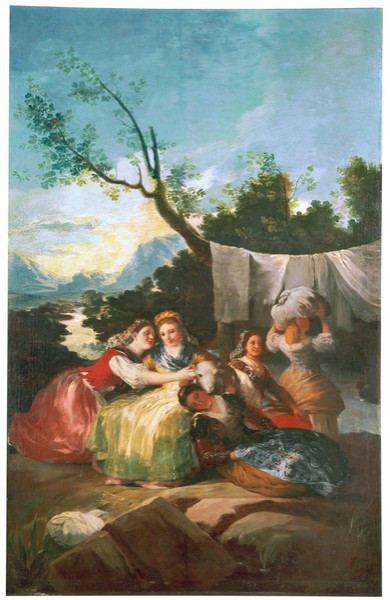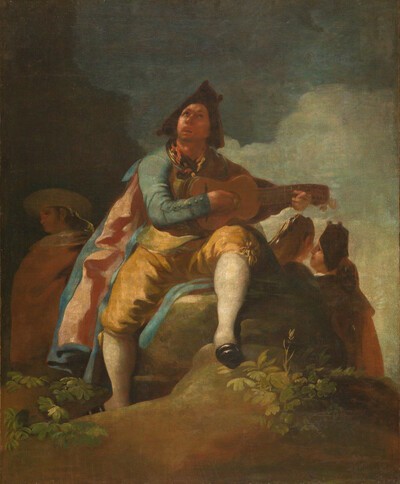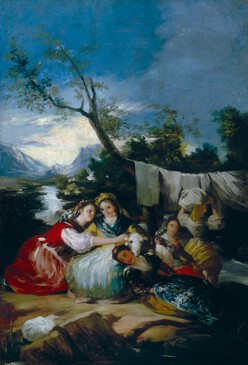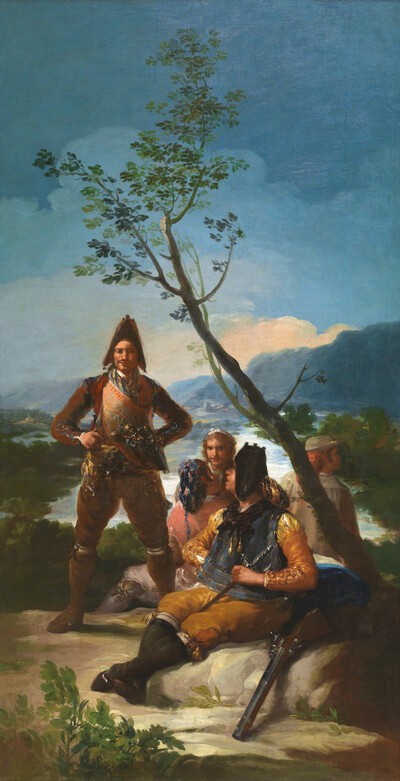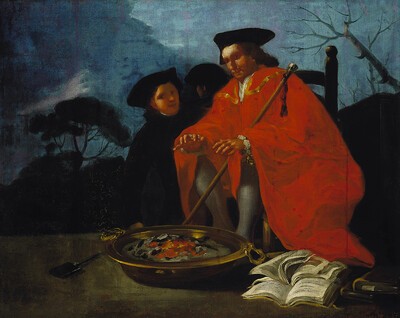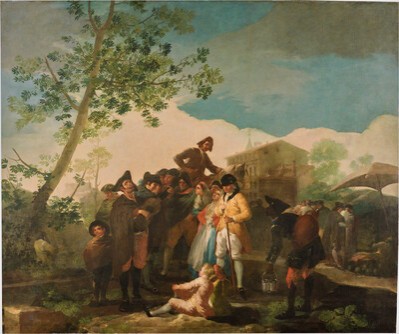- Cronología
- 1778 - 1780
- Ubicación
- The Prado National Museum. Madrid, Madrid, Spain
- Dimensiones
- 257.5 x 166 cm
- Técnica y soporte
- Oil on canvas
- Reconocimiento de la autoría de Goya
- Documented work
- Titular
- El Prado National Museum
- Ficha: realización/revisión
- 24 Nov 2009 / 14 Jun 2023
- Inventario
- (P00786)
See The Blind Guitarist.
This cartoon was delivered to the Royal Tapestry Factory on 24 January 1780, along with ten other cartoons, completing the decoration of the antechamber to the bedroom. These eleven tapestry cartoons - almost certain to have been made between 21 July 1779, when the artist delivered A Stickball Game and The Swing, and this delivery in January 1780 - were executed very rapidly. It is very likely that Goya was aware of the planned suspension of manufacturing work at the factory and was anxious to finish his commissions and receive his wages.
Around 1856 or 1857, the cartoon was moved from the Royal Tapestry Factory of Santa Bárbara to the Royal Palace in Madrid. In 1870, it was taken to the Prado Museum under orders given on 18 January and 9 February.
The Washerwomen was one of the main tapestries on the north wall of the antechamber, along with The Swing.
A group of washerwomen take a rest from their work to sit by the riverbank. The head of a lamb appears between the women and one of them holds the animal by a horn. Tomlinson sees some very clear sexual connotations in this scene, including symbols that Goya would have been aware of through some works in the library of his brother-in-law Francisco and which would not have escaped the attention of viewers at the time. The washerwoman was considered to be of the lower class, just like the majas, and her reputation would have been doubtful. As such, her appearance here is a representation of female lasciviousness. In fact, there existed a royal decree at the time prohibiting the washerwomen working along the Manzanares river from attracting the attention of passers-by with their provocative gestures. The presence of the ram would have been to make reference to its horns, which implied an offence for Spaniards in Goya's time. It seems clear that these details would not have been overlooked by viewers of the time.
Of particular interest in this painting are the quality of the colouring, the dramatic sky, and the tones reminiscent of the work of Velázquez, as pointed out by Sambricio, in the background landscape.
Around 37 cm has been lost from the height of the work compared to the size of the tapestry and to the dimensions on the invoice that Goya delivered to the Royal Tapestry Factory.
-
Goya. 250 AniversarioMuseo Nacional del PradoMadrid1996consultant editor Juan J. Luna. From March 29th to June 2nd 1996cat. 26
-
Goya. La imagen de la mujerMuseo Nacional del PradoMadrid2001from October 30th 2001 to February 10th 2002. Exhibitied also at the National Gallery of Art, Washington, March 10th to June 2nd 2002, consultant editor Francisco Calvo Serrallercat. 5
-
Goya luces y sombrasCaixaForumBarcelona2012consultant editors José Manuel Matilla and Manuela B. Marqués. From March 16th to June 24th 2012cat. 14
-
Goya en Madrid. Cartones para tapices 1775-1794Museo Nacional del PradoMadrid2014p. 227
-
L'œuvre peint de Goya. 4 volsParís1928-1950vol. I, p. 79, cat. 20
-
Tapices de GoyaMadridPatrimonio Nacional1946pp. 114-116, 232, cat. 29 y láms. 122-12
-
Vie et ouvre de Francisco de GoyaParísOffice du livre1970pp. 76, 89, cat. 132
-
BarcelonaPolígrafa1970vol. I, pp. 248-249, cat. 87
-
L’opera pittorica completa di GoyaMilanRizzoli1974pp. 95-96, cat. 90
-
Francisco de Goya, 4 vols.ZaragozaCaja de Ahorros de Zaragoza, Aragón y Rioja1980-1982vol. I, p. 112 y vol II. p. 64 (il.)
-
Francisco de Goya, cartones y tapicescol. col. "Espasa Arte"Espasa Calpe1987pp.104-105, 152, 190, 273, cat. 33C y p.
-
Francisco de Goya. Los cartones para tapices y los comienzos de su carrera en la corte de Madridcol. col. "Ensayos de Arte Cátedra"MadridCátedra1987pp. 134-137 y p. 135 (il.)
-
Goya. 250 AniversarioMadridMuseo del Prado1996pp. 306-307, cat. 26 y p. 101 (il.)
-
Salas del Palacio Real de El Pardo para las que se tejieron tapices sobre cartones de Francisco de Goya: identificación de las habitaciones y ajuste de las obras de Goya en los alzados de las paredesin HERRERO CARRETERO, Concha (curator, Tapices y cartones de Goya (catalogue of the exhibition organizated at the Palacio Real de Madrid, from may to june 1996)MadridPatrimonio Nacional, Goya 96, Lunwerg1996p. 169 (il.)
-
Goya en Madrid. Cartones para tapices 1775-1794MadridMuseo Nacional del Prado2014p. 227
